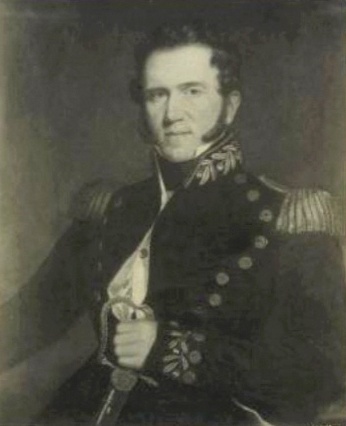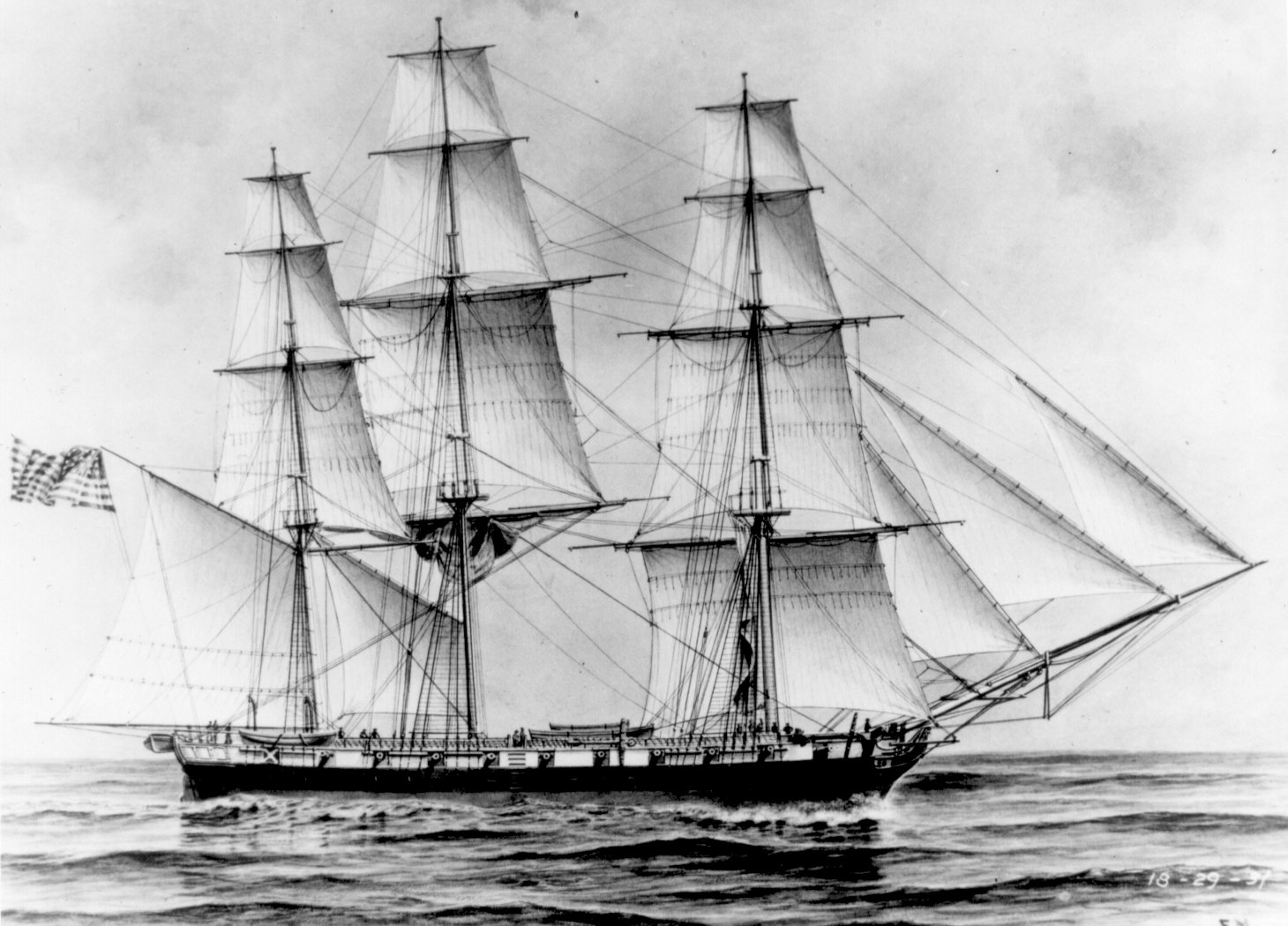
USS Erie
The USS Erie was a three-masted, wooden-hulled war sloop of the United States Navy in the early 19th century.
It was built at a cost of $ 25,461.05, launched on November 3, 1813 by Thomas Kemp (1779-1824) in Baltimore, Maryland, and sailed for the first time on March 20, 1814, under the command of American commander Charles Goodwin Ridgely (1784-1848).
Erie left New York in November 1823 to serve in the Mediterranean until 1826. From 1827 to 1832, she was based in Pensacola, Florida, and returned north to New York or Norfolk, Virginia for necessary repairs.
Erie patrolled the West Indies and the coast of Mexico, protecting American citizens and property, suppressing the slave trade, and summoning traders.
Characteristics
The USS Erie could carry up to 509 tons of cargo, and it's length was 117 feet 11 inches (35.94 m). The ship's beam was 31 feet x 6 inches (9.60 m) and the clamping depth was 4.42 m (14 feet 6 inches).
In turn, the 2 18-pound guns were the main armament and carried 20 x 32-pound carronades.
Portrait of the USS Erie in 1827
A portrait of the USS Erie, the war sloop of Captain Daniel Turner Foster (1794-1850), depicted with sails lowered amid a turbulent seascape and two figures near the stern, inscribed in Latin which translates as .. 'And the waves beat to one side; a steep mountain of water pursues with great violence', taken from the book Aeneid written in the 1st century BC by the Roman poet Virgilio (70 BC-19 BC). This description of the American ship Erie in the midst of a hurricane, which began on day 3 and continued unabated with violence until September 7, 1827, is respectfully dedicated to Captain Daniel Turner (1794-1850), who was in command of the ship, by your most obedient and humble servant, Constantine Smith.
The 1826 naval register lists Constantine Smith as a second lieutenant, and it seems likely that he made or commissioned the current portrait of the ship for Captain Turner (1794-1850), as a reminder of the time aboard the USS Erie.
An investigation of the inscribed coordinates points the ship to a location in the North Atlantic Ocean, approximately 600 kilometers northwest of Bermuda at the time of the hurricane.
"Respectfully dedicated to Daniel Turner by his most obedient and humble servant, Constantine Smith."
Battle of Lake Erie / September 10, 1813
Following his performance in the Battle of Lake Erie, Captain Turner (1794-1850) continued his service under Oliver Hazard Perry (1785-1819) on the frigate Java and the schooner Nonsuch, before taking command of USS Erie.
From there, he patrolled the Mediterranean as part of Commodore William Bainbridge's (1774-1833) squad, eventually returning to New York for repairs in 1820. After another stint in the Mediterranean from 1823 to 1826, Turner was successful in command of the ship from 1827 to 1830.
During this period, Turner and his crew protected American interests in the West Indies and Mexico while, at the same time, fighting the slave trade.

USS Erie / American War Sloop
The USS Erie was a three-masted, wooden-hulled war sloop of the United States Navy in the early 19th century.
Launch
The USS Erie was launched on November 3, 1813 by Thomas Kemp (1779-1824) in Baltimore, Maryland, and sailed for the first time on March 20, 1814, under the command of Charles Goodwin Ridgely (1784-1848).
Service
Unable to reach the open sea because of the British blockade at Hampton Roads,[2] Erie was forced to return to Baltimore 7 April 1814 where she remained berthed at Baltimore without a crew until early in 1815. [3]
On 8 May she sailed to Boston, Massachusetts to join Commodore William Bainbridge's squadron sailing for the Mediterranean 2 July.
With peace concluded with Algiers before the squadron reached the area, the squadron returned to the United States, leaving Erie to cruise with the naval force assigned to protect commerce and guard against any further disturbance of peace by the Barbary States. She remained on station for 4 years, sailing from Gibraltar for home 27 November 1819.
After calling at Madeira and in the West Indies, she reached New York 20 January 1820, and was laid up there for repairs for 3½ years. [4]
Lengthened to 122 feet (37 m) and with her tonnage increased to 611 tons, Erie sailed from New York in November 1823 to serve in the Mediterranean until 1826.
From 1827 to 1832, she was based at Pensacola, Florida, returning north to New York or Norfolk, Virginia for necessary repairs. During this time, Erie patrolled the West Indies and the coast of Mexico, protecting American citizens and property, suppressing the slave trade, and transporting merchants. [5]
After lying in ordinary at Boston from 21 August 1832 to 24 June 1834, Erie served on the Brazil Station for 3 years, as flagship during the last two.
During a period of revolution and other political disturbance, her squadron gave protection to Americans and their commerce, and provided vital intelligence concerning Brazil, Uruguay, and Argentina. She was again in ordinary at Boston from 15 September 1837 to 4 February 1838, and on 9 February sailed to cruise the Atlantic coast to aid any merchantmen she might find in distress.
In July, she sailed to Pensacola to patrol the West Indies and Gulf of Mexico for 2 weeks, guarding American interests during the French blockade of Mexican ports. [6]
Between July 1840 and February 1843, Erie was rebuilt at Boston, and converted into an armed storeship. She sailed for the Pacific 9 February, delivered supplies to ships on the Brazil Station en route, and reached Callao, Peru, 27 July. During a cruise to the Hawaiian Islands between November 1843 and January 1844, she served as the flagship and, in June 1844, set sail for New York, arriving on November 10. [7]
Erie crossed the Atlantic to supply the African Squadron, then repaired at New York, returning to the Pacific Squadron 18 November 1845.
When the Mexican-American War opened, Erie was in the Hawaiian Islands, but she returned to the coasts of Mexico, California, and Panama in August 1846, to supply the fleet in its operations at sea and in landings. She participated in the occupation of Mazatlán 11 November 1847, and shortly thereafter sailed for the east coast, reaching New York 24 June 1848. [8]
Last Voyages
The USS Erie set sail for the coast of Africa and the Mediterranean on September 15, 1848 to deliver supplies to ships at those stations. She returned to New York 11 July 1849, and between 6 September 1849 and 12 September 1850, twice more voyaged to the Mediterranean with supplies.
She was sold in New York 26 November 1850. [9]
References
- Bourne, M. Florence (December 1954). "Thomas Kemp, Shipbuilder: and His Home, Wades Point". Maryland Historical Magazine. XLIX: 279.
- Roosevelt, 1883 p. 162
- Cooper, 1856 p. 399
- U.S.Navy, DANFS, Erie prgh. 2
- U.S.Navy, DANFS, Erie prgh. 3
- U.S.Navy, DANFS, Erie prgh. 4
- U.S.Navy, DANFS, Erie prgh. 5
- U.S.Navy, DANFS, Erie prgh. 6
- U.S.Navy, DANFS, Erie prgh. 7
Bibliography
- Paullin, Charles Oscar (1910). Commodore John Rodgers: Captain ... The Arthur H. Clark Company, Cleveland, Ohio. p. 434. Url
- Cooper, James Fenimore (1826). History of the Navy of the United States of America.
Stringer & Townsend, New York. p. 508. OCLC 197401914. Url - Maclay, Edgar Stanton (1894). A History of the United States Navy, from 1775 to 1893.
D. Appleton & Company, New York. pp. 647. Url - Dept U.S.Navy. "Erie". Dictionary of American Naval Fighting Ships.
Department of the Navy -- Naval Historical Center. Retrieved 18 October 2011.





